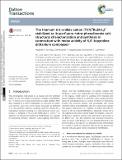The titanium tris-anilide cation [Ti(N[[superscript t]Bu]Ar)[subscript 3]][superscript +] stabilized as its perfluoro-tetra-phenylborate salt: structural characterization and synthesis in connection with redox activity of 4,4'-bipyridine dititanium complexes
Author(s)
Spinney, Heather A.; Clough, Christopher R.; Cummins, Christopher C.
DownloadSpinney-2015-Titanium tris-anilide.pdf (2.181Mb)
PUBLISHER_CC
Publisher with Creative Commons License
Creative Commons Attribution
Terms of use
Metadata
Show full item recordAbstract
This work explores the reduction of 4,4′-bipyridine using two equivalents of the titanium(III) complex Ti(N[[superscript t]Bu]Ar)[subscript 3] resulting in formation of a black, crystalline complex, (4,4′-bipy){Ti(N[[superscript t]Bu]Ar)[subscript 3]}[subscript 2], for which an X-ray structure determination is reported. The neutral, black, 4,4′-bipyridine-bridged bimetallic was found to be redox active, with mono- and di-anions being accessible electrochemically, and with the mono- and di-cations also being accessible chemically, and isolable, at least when using the weakly coordinating anion [B(C[subscript 6]F[subscript 5])[subscript 4]][superscript −] as the counter-ion. It proved possible to crystallize the salt [(4,4′-bipy){Ti(N[[superscript t]Bu]Ar)[subscript 3]}[subscript 2]][B(C[subscript 6]F[subscript 5])[subscript 4]][subscript 2] for a single-crystal X-ray structure investigation; in this instance it was revealed that the aromaticity of the 4,4′-bipyridine ligand, that had been disrupted upon reduction, had been regained. A rare cationic d[superscript 0] metal tris-amide complex, shown by X-ray crystallography to contain an intriguing pyramidal TiN[subscript 3] core geometry, namely {Ti(N[[superscript t]Bu]Ar)[subscript 3]}[superscript +], could also be isolated when using [B(C[subscript 6]F[subscript 5])[subscript 4]] as the essentially non-interacting counter-ion. This highly reactive cation should be considered as a potential intermediate in the plethora of reactions wherein Ti(N[[superscript t]Bu]Ar)[subscript 3] has been shown to effect the reduction of substrates including halogenated organic molecules, carbonyl compounds, organic nitriles, and metal complexes.
Date issued
2015-02Department
Massachusetts Institute of Technology. Department of ChemistryJournal
Dalton Transactions
Publisher
Royal Society of Chemistry
Citation
Spinney, Heather A., Christopher R. Clough, and Christopher C. Cummins. “The Titanium Tris-Anilide Cation [Ti(N[[superscript t]Bu]Ar)[subscript 3]][superscript +] Stabilized as Its Perfluoro-Tetra-Phenylborate Salt: Structural Characterization and Synthesis in Connection with Redox Activity of 4,4′-Bipyridine Dititanium Complexes.” Dalton Trans. 44, no. 15 (2015): 6784–6796. © 2015 Royal Society of Chemistry
Version: Final published version
ISSN
1477-9226
1477-9234